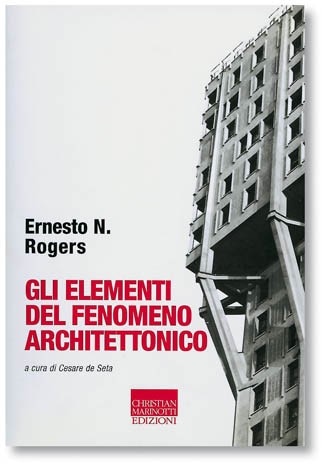Gli elementi del fenomeno architettonico Ernesto N. Rogers, A cura di Cesare De Seta, Christian Marinotti Edizioni, Milano 2006 (pp. 172, € 14,00)
Ernesto Nathan Rogers wrote this book for a university chair competition. His aim was to illustrate “the many potential routes” open to young people interested in architecture and introduce them to the problems of the trade. “Architecture is an overall manifestation. It cannot be split into parts nor can it be estranged from the evolution of the historic, social and cultural reality in which its development becomes an open issue.” The book has had a long adventure, as its editor Cesare De Seta reminds us. Rogers, perhaps overtaken by doubt and having rethought it all from the beginning, withdrew it from the market immediately after it was published by Laterza in 1961. Subsequently, thanks to De Seta, the book was published by Guida in 1981 and is now being republished by Marinotti. Although the writing does not possess the clarity and energy of Rogers’s spoken language, we do believe the essay is a useful working tool, for both students and lovers of architecture. As previously pointed out by the editor, the book is not intended to serve as a manual instructing people how to become architects, but as a spur to raise awareness regarding the problems of construction practices. The text describes the difficulties linked to design as a task rather than a profession, a mission “to give people a house, an overall environment, that is organic to the needs of our times”. Regardless of its lack of editorial success the book has always captured the attention of critics and scholars, who have highlighted its educational and even maieutic aspect. This is doubtlessly because of the stance Rogers adopted with young people and all those taking an interest in the architectural debate. At a conference on Rogers held in Milan in 1993 by the Department of Design, Aurelio Cortesi grasped the more informal aspect of this essay in which the dialogue adapts to the various interlocutors, their needs and their problems. He appealed to a more mature and amiable argument, dwelling less on the principles and set finalistic rules and more on the pedagogical and colloquial act, summarised historically and compared with the various teaching levels of the individual disciplines. According to Cortesi, Rogers adapts to the various interlocutors and demonstrates this ability by giving credit to each one and stimulating everyone’s originality and potential to the utmost. Giampiero Calza, on the other hand, highlights the importance of the tension between past and future, the sentiment of a dual masterly achievement, “the fame and thirst for knowledge and renewal” that would later be found in the projects by Rogers’s students, inspired by the utopia of reality. Gropius remained Rogers’s fundamental cultural reference with regard to teaching method, but the author was also open to lessons from other fronts of the contemporary world. Architecture may be created by experts but it is intended for all and can never be seen as mere technical datum; it cannot simply respond to the specific needs of the moment but must stand at the crossroads of life’s space and time. Simultaneously, he suggested that we adopt his masters: Van de Velde, Wright, Le Corbusier and Mies van der Rohe. But he also invites us to go further. “Rogers himself says that there are no masters to copy, but rather architecture from which to learn how to build.” We think Rogers wanted to say that it was an illusion to consider a project separate from thought and awareness; only through knowledge could there be action, the design of an architectural project. “Conceptually,” writes Rogers, “architecture is synonymous with life. Not only what we experiment in ourselves but that which bears witness to our passage between present living and future living. Building architecture is about turning the past into the present and the present into the future. Those who do not understand these principles should not be architects or teach others how to become them.” It is for this lesson that we consider him a master. The book is divided into four chapters plus a preamble, a conclusion and 25 plates. Yet again, Rogers’s talent lay in the way he combined great interest in the pure discipline of architecture with a focus on individual identity and the invitation to look deep inside ourselves and our culture. Claudio Camponogara Architect


